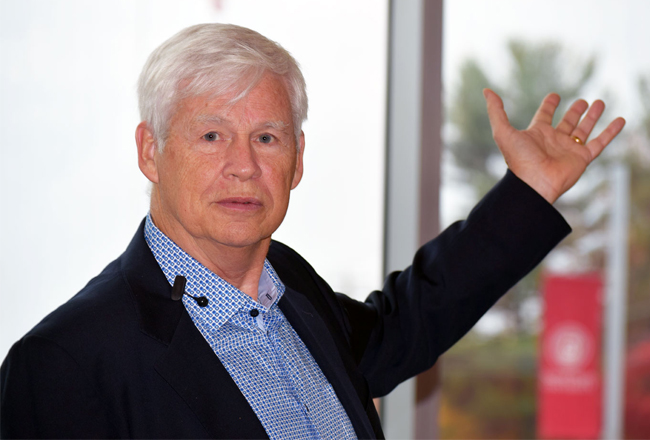It is 10 years since the Lehman Brothers bankruptcy,” observed Robert F. Engle, the 2003 Nobel Prize for Economics laureate, during a recent presentation at Sacred Heart University”™s Center for Applied Business Research. “At the time, we had very sketchy theories about systemic risk, whether we could have financial meltdowns or not. Over the last decade, we learned lots of things. We have lots of research now that helps us understand where financial crises come from and how likely they are to happen again.”
In a presentation titled “How Much SRISK is Too Much” ”” the acronym stands for “systemic risk,” where an event impacting a single company could trigger the downfall of an industry or economy ”” Engle compared the current financial services environment to a photograph he took of a volcano in Patagonia.

“It is dormant,” Engle said of the majestic mountain where the volcano sleeps. “But if you look closely there is a little wisp of smoke coming out of there. And that”™s kind of the analogy we are thinking about with the financial system. Is it really dormant and benign, or are there risks out there that we need to know about?”
Engle, who is the Michael Armellino Professor of Finance at New York University”™s Stern School of Business, discussed government-conducted stress tests of the largest banks to determine whether they carry enough capital to survive an economic crisis. It is at this level, he added, that problems in understanding systemic risk are revealed.
“What they are asking in each case,” he said about the government agencies conducting the stress tests, “is if there is a stress in the economy, would the bank be able to survive? When you say it that way, it is clear that you are thinking about the financial crisis being caused by some sort of external shock, which hits the financial sectors and makes banks fail. But when you think about the financial crisis, it”™s not so much an external shock, it is really more of an internal shock that shakes the financial sector.”
Engle also warned banks that are undercapitalized can make a bad situation worse in how they approach risk stabilization.
“They could do nothing and either hope for good luck that time will cure this, or that they will get a bailout,” he said. “They could sell their shares of stocks, because banks often have issues that have not been sold to the public. Or they could sell some of their assets and get dollars from them to pay off the debt.”
All of these approaches, Engle warned, create more problems than solutions: hoping for either a lucky break or a government bailout is not realistic, while selling a wave of hitherto unavailable shares would reduce the value of shares already on the market. As for selling off assets, Engle recalled that was used in the Great Recession, when mortgage-backed securities were dumped on the market.
Engle pointed out that the federal government required just under $1 trillion to bail out the major financial institutions during the Great Recession. Lehman Brothers, whose bankruptcy triggered the economic meltdown, was not bailed out ”” and Engle observed that in 2008, Lehman Brothers was the 11th largest financial institution in the country, missing out on federal aid while the nation”™s 10 largest financial institution were recipients of funds from the Troubled Asset Relief Program (TARP) signed into law by President George W. Bush on Oct. 3, 2008.
Looking ahead, Engle predicted that another meltdown at the level of the 2008 crash would require at least $3.5 trillion to bail out the global financial system. “China looks like it would need $1 trillion to bail out the Chinese banks,” he said, adding that Japan, France, the U.K. and the U.S. would round out a top five of nations posing the greatest risk of a new banking collapse.
As for the U.S. banking industry, Engle estimated that Citigroup would need “about $48 billion to recapitalize if we had another financial crisis like the last time.” Other major banking corporations requiring financial bailouts would be Prudential Financial and Goldman Sachs seeking $28 billion infusions each and Morgan Stanley requiring $26 billion, Engle stated.
But is this all theory? Engle grimly acknowledged that Trump administration tariffs placed on Chinese goods have “hurt China quite substantially. A lot of the risk we”™re facing is China”™s response to the policies that we”™ve done.”
As for his antidote to stave off another banking meltdown, Engle recommended diplomacy rather than trade wars. “We are not doing a very good job,” he said. “We are not really communicating monetary policies and politics among countries. We are all one world and we have to solve these problems together.”





















